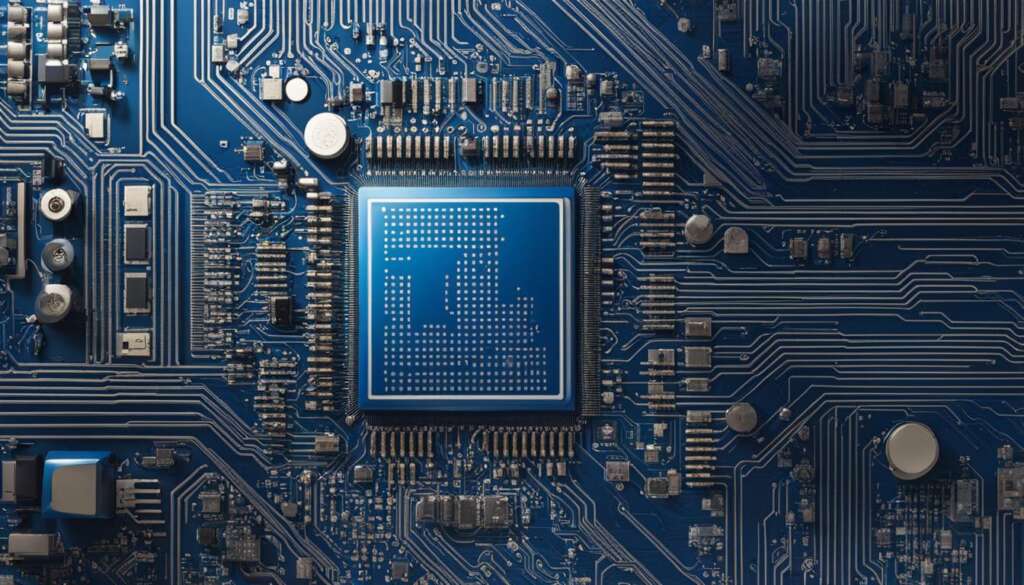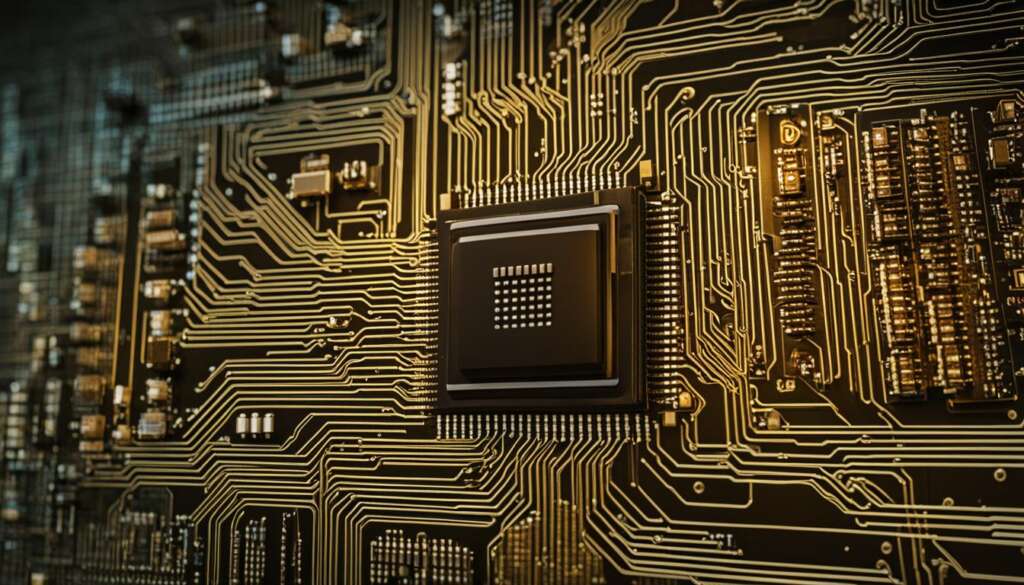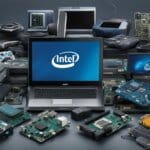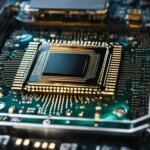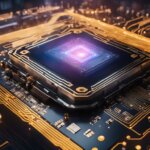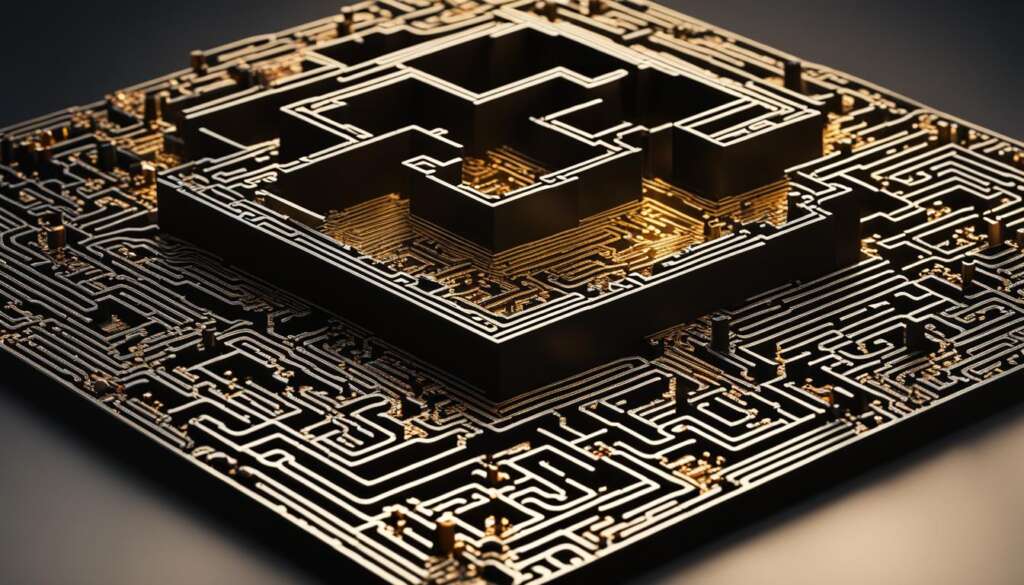Table of Contents
From the humble beginnings of a single microchip, the microprocessor emerged as a catalyst for technological advancement and a key driver of computing evolution. Its invention marked a turning point in the history of computing, igniting a revolution that continues to shape our digital world today.
The significance of microprocessors cannot be overstated. These innovative chips, also known as CPUs (central processing units), have transformed the way we interact with computers and electronic devices across all scales. From the smallest consumer appliances to the most powerful supercomputers, microprocessors have revolutionized the way we live, work, and connect with the world.
The development of the microprocessor was not an overnight feat. It took decades of relentless pursuit and innovation, driven by the concept of Moore’s Law. This law describes the exponential progress in the number of transistors that can be fabricated on a single chip, resulting in a tremendous increase in processing power that has propelled technology forward.
With each generation of microprocessors, the world witnessed leaps in computing capabilities. These tiny powerhouses revolutionized diverse industries, enabling unparalleled advancements in fields such as artificial intelligence, mobile technology, and scientific research. The microprocessor’s influence has been felt in every aspect of our lives, from the way we communicate to the way we navigate the complexities of modern existence.
As we dive deeper into the history of microprocessors, we will explore the transformative impact they have had and continue to have on our world. Join us on this journey through the evolution, significance, and future of microprocessors as we unravel the threads that connect these remarkable inventions to the fabric of our digital age.
A Brief History of the Microprocessor
The history of the microprocessor is a fascinating journey that has transformed the world of computing. It all began in the 1970s with the development of the Intel 4004, the first microprocessor. This groundbreaking invention laid the foundation for the technological advancements that would follow. The Intel 4004 was a 4-bit processor that revolutionized computing by integrating multiple functions onto a single chip. It marked the birth of a new era in computing and set the stage for further innovation.
Following the Intel 4004, a wave of 8-bit microprocessors emerged in the 1970s, including the Intel 8008, the Motorola 6800, and the MOS Technology 6502. These 8-bit microprocessors played a pivotal role in the home computer revolution, making computers more affordable and accessible to the general public. The introduction of these microprocessors sparked a wave of excitement and innovation in the industry, fueling the rise of the personal computer market.
The 1980s witnessed another significant development in microprocessor technology with the introduction of 16-bit processors. One notable example is the Intel 8086, which laid the foundation for the IBM PC, one of the most influential computers in history. The IBM PC, powered by the Intel 8088 microprocessor, brought computing into homes and businesses around the world, revolutionizing the way people work and interact with technology.
| Microprocessor | Year |
|---|---|
| Intel 4004 | 1971 |
| Intel 8008 | 1972 |
| Motorola 6800 | 1974 |
| MOS Technology 6502 | 1975 |
| Intel 8086 | 1978 |
The evolution of microprocessors continued with the introduction of Reduced Instruction Set Computing (RISC) architecture in the 1980s. RISC processors, such as the IBM POWER1, offered improved performance and efficiency by simplifying the instruction set. This architectural shift paved the way for further advancements in microprocessor technology and laid the groundwork for the future of computing.
In summary, the history of the microprocessor is a story of constant innovation and progress. From the humble beginnings of the Intel 4004 to the powerful and complex microprocessors of today, this technology has shaped the course of computing history. The journey from 4-bit processors to RISC architecture has transformed the way we live, work, and interact with technology, and it continues to push the boundaries of what is possible.

Advantages of Microprocessors
Microprocessors have played a pivotal role in shaping the landscape of computing, offering a multitude of advantages that have revolutionized technology and improved performance across various industries.
One of the key advantages of microprocessors is their exceptional processing speed. With the ability to execute instructions at an incredibly fast rate, microprocessors enable swift data processing and enhance overall system performance. This speed is especially crucial for applications that require real-time data processing, such as video editing or gaming.
Another significant advantage is the compact size of microprocessors. By integrating multiple functions onto a single chip, microprocessors have made electronic devices smaller and more portable. This miniaturization has led to the development of highly advanced smartphones, tablets, and wearable devices that can be comfortably carried and used anywhere.
Microprocessors also offer easy maintenance and flexibility. Their modular design allows for easy replacement and upgrades, minimizing downtime and reducing costs. The flexibility of microprocessors allows them to be used in a wide range of applications, from consumer electronics to industrial automation and artificial intelligence.
Microprocessors have revolutionized technology, providing unparalleled processing speed, compactness, easy maintenance, and flexibility. These advantages have paved the way for innovative advancements and improved the performance of various electronic devices.

| Advantages of Microprocessors |
|---|
| Processing Speed |
| Compact Size |
| Easy Maintenance |
| Flexibility |
| Improved Performance |
Disadvantages of Microprocessors
Despite their many advantages, microprocessors have some limitations that can impact their performance and functionality. Understanding these disadvantages is crucial in order to make informed decisions when designing and using microprocessor-based systems.
Overheating
One of the main challenges with microprocessors is overheating. Due to their compact size and high processing power, microprocessors generate a significant amount of heat. If not properly managed, this heat can lead to performance issues, system instability, and even permanent damage to the processor. Overheating can occur when the processor is subjected to heavy usage for prolonged periods or when the cooling system is inadequate.
Performance Dependence on Data Size
Microprocessors have a performance limitation related to the size of the data being processed. While they excel at handling small data sets and executing instructions quickly, their performance can be affected when working with larger data sets. Processing large amounts of data can lead to increased latency and reduced overall performance. This limitation is particularly relevant in applications that require intensive data processing, such as scientific calculations, simulations, or big data analytics.
Lack of Support for Floating-Point Operations
Another limitation of microprocessors is the lack of native support for floating-point operations. Floating-point operations involve calculations with decimal numbers, which are common in scientific, engineering, and financial applications. While microprocessors can perform floating-point operations, they often rely on software-based algorithms or coprocessors to handle these calculations. This can introduce additional complexity and overhead, affecting both performance and energy efficiency.
| Disadvantages | Description |
|---|---|
| Overheating | Due to high processing power, microprocessors generate heat that can lead to performance issues and damage. |
| Performance Dependence on Data Size | Microprocessors may experience reduced performance when processing larger data sets. |
| Lack of Support for Floating-Point Operations | Native support for floating-point operations is limited in microprocessors, requiring additional software or coprocessors. |
Transformation of Computing Through Microprocessors
Microprocessors have played a pivotal role in transforming the field of computing, ushering in a new era of general-purpose computing. From personal computers (PCs) to mobile phones, the impact of microprocessors can be felt across various industries and aspects of our daily lives. With the advent of the Internet of Things (IoT) and artificial intelligence (AI), microprocessors have become even more critical in driving technological advancements.
One of the most significant transformations brought about by microprocessors is the widespread availability of general-purpose computers. PCs, powered by microprocessors, have become indispensable tools for both work and leisure. These machines have revolutionized how we work, communicate, and access information, enabling us to perform tasks such as writing documents, browsing the internet, and editing multimedia with ease. The power and flexibility of microprocessors have also given rise to mobile phones, which have become essential devices for communication, entertainment, and accessing a wealth of digital services on the go.
Microprocessors have enabled the development of smart devices and IoT applications, which have revolutionized various industries. From smart homes to wearable devices, microprocessors serve as the brain behind these interconnected systems. They enable devices to communicate, collect data, and perform complex tasks, bringing convenience and efficiency into our everyday lives.
Furthermore, microprocessors have empowered the rise of artificial intelligence and machine learning. The processing capabilities of microprocessors allow for the execution of complex algorithms and deep neural networks, enabling AI systems to recognize patterns, learn from data, and make intelligent decisions. This has opened up possibilities for advancements in fields such as healthcare, finance, and autonomous vehicles, shaping the future of technology and innovation.
| Industry | Impact of Microprocessors |
|---|---|
| Personal Computing | Enabled the development of PCs and laptops, transforming the way we work, communicate, and access information. |
| Mobile Technology | Brought about the era of smartphones and mobile devices, providing ubiquitous connectivity and access to digital services. |
| Internet of Things (IoT) | Empowered the creation of interconnected smart devices, enabling automation, data collection, and seamless integration of technology into our daily lives. |
| Artificial Intelligence (AI) | Enabled the development of AI systems and machine learning algorithms, revolutionizing industries with intelligent decision-making and pattern recognition. |
In summary, microprocessors have been instrumental in the transformation of computing. From the widespread availability of general-purpose computers to the rise of smart devices, IoT, and AI, microprocessors continue to drive technological advancements and shape the future of computing. The power and versatility of microprocessors have revolutionized industries, enhanced productivity, and enabled new possibilities for innovation and progress.
The Future of Microprocessors: Unlocking Infinite Possibilities
As we enter the next era of computing, the future of microprocessors is poised to redefine the limits of technology. One of the most exciting advancements on the horizon is quantum computing. Quantum microprocessors, based on the principles of quantum mechanics, have the potential to revolutionize computing power by performing computations at speeds exponentially faster than traditional processors. These quantum machines can tackle complex problems that were once thought to be unsolvable, opening doors to breakthroughs in cryptography, optimization, and scientific research.
Another area of rapid advancement is in the field of artificial intelligence (AI). Microprocessors optimized for AI algorithms are paving the way for intelligent machines capable of autonomous decision-making, machine learning, and natural language processing. These advancements have far-reaching implications across industries, from healthcare and finance to transportation and entertainment. With AI-powered microprocessors, the boundaries of what machines can achieve are constantly pushed, transforming the way we live, work, and interact with technology.
“The development of microprocessors tailored for neural networks is driving the evolution of machine learning and deep learning systems. These processors are designed to efficiently handle the complex calculations required for training and inference in neural networks. With increased processing power and efficiency, neural network-based microprocessors are accelerating progress in areas such as computer vision, speech recognition, and natural language processing, leading to significant advancements in technology and human-machine interaction.
Additionally, as the Internet of Things (IoT) continues to expand, microprocessors are becoming a fundamental component of connected devices. Edge computing, which brings processing power closer to the source of data, is enabling faster response times, efficient data management, and real-time analytics. Microprocessors embedded in IoT devices drive seamless connectivity, enabling the creation of smart homes, intelligent cities, and interconnected industrial systems. The future of microprocessors in the IoT space holds tremendous potential for innovation and transformation.
The Future of Microprocessors: A Glimpse into the Possibilities
The potential of future microprocessors is vast, with quantum computing, AI optimization, and IoT advancements leading the way. These technologies will reshape industries, revolutionize scientific research, and redefine the boundaries of what is possible. As we embark on this journey into the future, we are poised to witness extraordinary breakthroughs driven by the relentless pursuit of innovation and the power of microprocessors.
| Advancements | Potential Applications |
|---|---|
| Quantum Computing | Cryptography, Optimization, Scientific Research |
| AI Optimization | Autonomous Decision-making, Machine Learning, Natural Language Processing |
| Neural Network-based Microprocessors | Computer Vision, Speech Recognition, Natural Language Processing |
| IoT Advancements | Smart Homes, Intelligent Cities, Interconnected Industrial Systems |
Conclusion
The invention of the microprocessor has had a profound impact on computing, leading to a revolution in technology and shaping the course of computing history. The integration of processing functions onto a single microchip has made computers smaller, faster, and more accessible to the masses. Microprocessors have transformed various industries, from personal computing to IoT and AI.
As technology continues to evolve, the future of computing holds even greater possibilities. Advancements in quantum computing, neural networks, and edge computing are opening up new avenues for innovation and progress. Quantum microprocessors, harnessing the power of quantum mechanics, have the potential to revolutionize industries including cryptography, drug discovery, and optimization problems.
We are living in a digital age filled with endless opportunities for innovation and progress. The journey of the microprocessor has brought us to a new era of computing, where the boundaries of what is possible continue to expand. The computing revolution initiated by the microprocessor is far from over, and the future holds exciting prospects for the world of technology.
FAQ
How did the invention of the microprocessor change the course of computing history?
The invention of the microprocessor revolutionized computing by integrating a computer central processing unit onto a single microchip. It has had a significant impact on technology, shaping the way we interact with computers and electronic devices.
What is the history of the microprocessor?
The history of the microprocessor dates back to the 1970s when the first microprocessor, the Intel 4004, was developed. This marked the beginning of a new era in computing. Throughout the 1970s, a range of 8-bit microprocessors emerged, playing a crucial role in the home computer revolution and making computers more affordable and accessible.
What advantages do microprocessors offer?
Microprocessors provide high processing speed, allowing for faster execution of instructions and more efficient data processing. They are also compact in size, contributing to the miniaturization of electronic devices and making them more portable.
What are the limitations of microprocessors?
One common limitation of microprocessors is overheating, which can affect performance and lifespan, especially with heavy usage. Additionally, the performance of microprocessors can depend on the size of the data being processed, and they may lack support for certain complex mathematical operations.
How have microprocessors transformed computing?
Microprocessors have enabled the development of general-purpose computers, such as personal computers (PCs), which have become essential tools in both personal and professional settings. They have also been instrumental in the advancement of various industries, including mobile phones, Internet of Things (IoT), and artificial intelligence.
What are the future possibilities and innovations with microprocessors?
The future of microprocessors holds exciting possibilities, including advancements in quantum computing, neural networks, and edge computing. These innovations have the potential to revolutionize industries such as cryptography, drug discovery, and optimization problems.
Source Links
- https://www.ncbi.nlm.nih.gov/pmc/articles/PMC5378251/
- https://www.pcmag.com/news/how-the-4004-changed-the-world
- https://www.pw.live/blogs-coding/what-is-microprocessor-and-how-it-has-changed-the-computer-science

